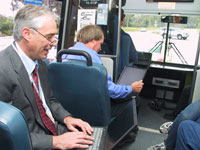Project: CyberShuttle and CyberShuttle2
PI: Ramesh Rao, Prof, Jacobs School of Engineering;
UCSD Division Director, Calit2
Division: UCSD
Corporate Partners: QUALCOMM, Ericsson
Start Date: April 2002
PDF: PDF
DOC: DOC
|

|
|
Unveiled on April 1, 2002, the UCSD CyberShuttle is believed to
be the world's first shuttle enabled with wireless, high-speed access
to the Internet. Faculty, staff, and students, using laptops and
handheld devices enabled with wireless cards, can connect to the
Internet at speeds comparable to those at home using DSL or a cable
modem while riding between the Sorrento Valley train station and
the main UCSD campus. Peak speeds have been measured at 2.4 megabits
per second while traveling at 65 miles per hour. This capability
is enabled by linking local-area 802.11b wireless technology with
QUALCOMM's 1xEV-DO wide-area network technology using cell sites
at EBU 1 on campus and QUALCOMM headquarters in Sorrento Valley.
All laptops, HP Jornada portable digital assistants (PDAs), and
PDAs running Pocket PC 2002 using the UCSD campus cyberinfrastructure
should work on the shuttle. One must have a wireless card and the
appropriate drivers. Visitors may need to set their SSID (network
name) to "UCSD" for shuttle wireless services.
This project leverages other development and prototyping through
the Always Best Connected project (involving Ericsson) and the San
Diego Traffic Report.
"Implementation of the PC changes the previously passive
environment to an active one," says researcher David Hutches,
and provides a medium to perform new experiments. "What might
you want to do or what content would be meaningful to you if
you found yourself on the shuttle for 20 minutes?" he wonders.
"That's the 'space' we're exploring."
|
The first shuttle
equipped with just an outbound link to the Internet is now being
extended to a fleet of up to four shuttles with bi-directional capability,
which will make it possible to push content to the shuttles. The
architecture on each shuttle, designed to accommodate content relevant
to shuttle location, time of day, and the interests of the passengers,
will feature new capabilities such as audio, video, GPS location
awareness, three 17-inch LCD displays, and a ruggedized PC. Anticipated
applications include a digital jukebox, GPS mapping to show a shuttle's
location on campus, and the development of content describing campus
activities taking place nearby as a shuttle passes. Researchers
involved in the project hope the riders will seize the opportunity
to develop interactive applications to support user-controllable
content via voice, cell phone, or haptics (e.g., hand signals).
This project is a collaboration among Calit2, Administrative
Computing and Telecommunications, the Jacobs School of Engineering,
and the Scripps Institution of Oceanography.
Contact: UCSD Network Operations, (858)534-1857
|

